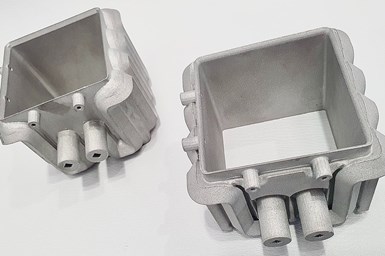Additive Flow’s Engineering Software for Optimizing Metal Additive Manufacturing
Formnext 2022: The software is said to offer the ability to optimize build parameters within approved CAD geometries to dramatically reduce cost, while improving productivity, reliability and repeatability.
Additive Flow’s production engineering software is designed to provide cost, time and quality efficiencies, enabling users achieve quality, consistency and repeatability in metal additive manufacturing (AM) applications.
The software’s capabilities include design, design optimization and workflow. The company says the software offers the ability to optimize build parameters within approved CAD geometries to dramatically reduce cost, while improving productivity, reliability and repeatability.
The platform is said to allocate the optimum build parameters at every location within the final model to achieve the desired objectives of each particular case. It leverages simultaneous, multiscale optimization encompassing material, manufacturing and quality so AM can be deployed for cost-effective serial production.
“Additive Flow exists to address common, unresolved challenges experienced across the production workflow for AM applications,” says Alexander Pluke, Additive Flow CEO. “Our software operates after the CAD stage and hands over to CAM, handling siloed data to integrate and improve production processes for AM in record times with validated outcomes.”
According to the company, many AM teams can be weighed down by excessive information and yet feel they lack data to make the best decisions. Additive Flow addresses this issue while also accelerating the workflow and improving production outcomes. Moreover, by working with world-class teams and facilities at the National Physics Laboratory and companies such as EOS, Autodesk and Airbus, Additive Flow has demonstrated its full capabilities in a variety of commercial projects.
- In this webinar, Zeiss presents leveraging a novel automated solution to comprehensively evaluate the effect of print parameters and process signatures on AlSiMg components.
Related Content
-
Copper, New Metal Printing Processes, Upgrades Based on Software and More from Formnext 2023: AM Radio #46
Formnext 2023 showed that additive manufacturing may be maturing, but it is certainly not stagnant. In this episode, we dive into observations around technology enhancements, new processes and materials, robots, sustainability and more trends from the show.
-
Meet The Cool Parts Showcase Winners
The Cool Parts Showcase winners for 2023 were announced at Formnext Forum Austin. Watch the award presentation here.
-
Semiconductors, Tungsten, AM Affordability and More from Formnext 2024: AM Radio #56
The trade show included increased applications for the semiconductor market, machine launches and technology advances aimed at cost cutting, plenty of LFAM and more. Listen to our conversation on Formnext 2024.















